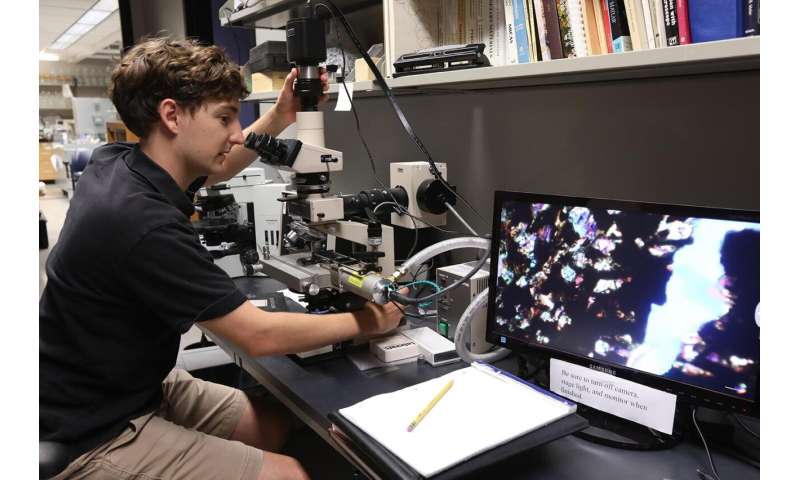by Carly Banks, Northern Arizona University

Graphic of conceptual design of the team’s shadow theory. Credit: Northern Arizona University
Is there life outside our planet?
The age-old question has long been asked by scientists and researchers without much progress in finding the answer.
There have been more than 4,200 exoplanets discovered outside our solar system, and while past techniques were developed to test for life on exoplanets, none of which tested for complex, non-technological life like vegetation. Now, space telescopes may soon be able to directly view these planets—including one within the habitable zone of the Earth's nearest star neighbor. With the help of these telescopes and a team of researchers in informatics and astronomy at Northern Arizona University, an answer to this question might not be so out of this world.
Funded by a NASA Habitable Worlds grant, a team of researchers, which includes Chris Doughty, David Trilling and Ph.D. student Andrew Abraham, published a study in the International Journal of Astrobiology that develops and tests a technique to determine whether specifically multicellular or complex-but-not-technological life can be uniquely detected outside the solar system.
In an attempt to find some answers, the team turned to one of Earth's most common multicellular life forms—trees. More specifically, their shadows.
"Earth has more than three trillion trees, and each casts shadows differently than inanimate objects," said Doughty, lead author on the paper and assistant professor in the School of Informatics, Computing, and Cyber Systems. "If you go outside at noon, almost all shadows will be from human objects or plants and there would be very few shadows at this time of day if there wasn't multicellular life."
The team hypothesizes that abundant upright photosynthetic multicellular life (trees) will cast shadows at high sun angles, distinguishing them from single cellular life. Therefore, using future space telescopes to observe the types of shadows cast should, in theory, determine if there are similar life forms on exoplanets.
"The difficult part is that any future space telescope will likely only have a single pixel to determine if life exists on that exoplanet," said Abraham, who worked closely with Doughty on the study. "So, the question becomes: Can we detect these shadows indicating multicellular life with a single pixel?"
With just one pixel to work with, the team had to make sure that the shadows detected in these telescopes were conclusively multicellular life, not other exoplanet features like craters.
"It was suggested that craters might cast shadows similar to trees, and our idea would not work," said Trilling, associate professor of astronomy. "So, we decided to look at the replica moon landing site in northern Arizona where the Apollo astronauts trained for their mission to the moon."
Drones were used at different times of the day to determine that craters did in fact cast shadows differently than trees.
The researchers then turned to imaging to determine if their theory would work on a large scale. By using the POLDER (Polarization and Directionality of Earth's Reflectance) satellite, the team was able to observe the shadows on Earth at different sun angles and times of day. The resolution was reduced to mimic what Earth would look like as a single pixel to a distant observer as it rotates around the sun. Then, the team compared this to similar data from Mars, the moon, Venus and Uranus to see if Earth's multicellular life was unique.
The team found that on parts of the planet where trees were in abundance, like the Amazon basin, multicellular life could be distinguished, but when it came to observing the planet as a whole as a single pixel, distinguishing multicellular life was difficult.
However, the potential that observing shadows brings to the conversation of life on exoplanets could be closer than scientists and researchers have ever been before. Doughty believes the technique remains valid in theory—a future space telescope could rely on the shadows found in a single pixel.
"If each exoplanet was only a single pixel, we might be able to use this technique to detect multicellular life in the next few decades," he said. "If more pixels are required, we may have to wait longer for technological improvements to answer whether multicellular life on exoplanets exists."
Explore further Looking for exoplanet life in all the right spectra
Is there life outside our planet?
The age-old question has long been asked by scientists and researchers without much progress in finding the answer.
There have been more than 4,200 exoplanets discovered outside our solar system, and while past techniques were developed to test for life on exoplanets, none of which tested for complex, non-technological life like vegetation. Now, space telescopes may soon be able to directly view these planets—including one within the habitable zone of the Earth's nearest star neighbor. With the help of these telescopes and a team of researchers in informatics and astronomy at Northern Arizona University, an answer to this question might not be so out of this world.
Funded by a NASA Habitable Worlds grant, a team of researchers, which includes Chris Doughty, David Trilling and Ph.D. student Andrew Abraham, published a study in the International Journal of Astrobiology that develops and tests a technique to determine whether specifically multicellular or complex-but-not-technological life can be uniquely detected outside the solar system.
In an attempt to find some answers, the team turned to one of Earth's most common multicellular life forms—trees. More specifically, their shadows.
"Earth has more than three trillion trees, and each casts shadows differently than inanimate objects," said Doughty, lead author on the paper and assistant professor in the School of Informatics, Computing, and Cyber Systems. "If you go outside at noon, almost all shadows will be from human objects or plants and there would be very few shadows at this time of day if there wasn't multicellular life."
The team hypothesizes that abundant upright photosynthetic multicellular life (trees) will cast shadows at high sun angles, distinguishing them from single cellular life. Therefore, using future space telescopes to observe the types of shadows cast should, in theory, determine if there are similar life forms on exoplanets.
"The difficult part is that any future space telescope will likely only have a single pixel to determine if life exists on that exoplanet," said Abraham, who worked closely with Doughty on the study. "So, the question becomes: Can we detect these shadows indicating multicellular life with a single pixel?"
With just one pixel to work with, the team had to make sure that the shadows detected in these telescopes were conclusively multicellular life, not other exoplanet features like craters.
"It was suggested that craters might cast shadows similar to trees, and our idea would not work," said Trilling, associate professor of astronomy. "So, we decided to look at the replica moon landing site in northern Arizona where the Apollo astronauts trained for their mission to the moon."
Drones were used at different times of the day to determine that craters did in fact cast shadows differently than trees.
The researchers then turned to imaging to determine if their theory would work on a large scale. By using the POLDER (Polarization and Directionality of Earth's Reflectance) satellite, the team was able to observe the shadows on Earth at different sun angles and times of day. The resolution was reduced to mimic what Earth would look like as a single pixel to a distant observer as it rotates around the sun. Then, the team compared this to similar data from Mars, the moon, Venus and Uranus to see if Earth's multicellular life was unique.
The team found that on parts of the planet where trees were in abundance, like the Amazon basin, multicellular life could be distinguished, but when it came to observing the planet as a whole as a single pixel, distinguishing multicellular life was difficult.
However, the potential that observing shadows brings to the conversation of life on exoplanets could be closer than scientists and researchers have ever been before. Doughty believes the technique remains valid in theory—a future space telescope could rely on the shadows found in a single pixel.
"If each exoplanet was only a single pixel, we might be able to use this technique to detect multicellular life in the next few decades," he said. "If more pixels are required, we may have to wait longer for technological improvements to answer whether multicellular life on exoplanets exists."
Explore further Looking for exoplanet life in all the right spectra
More information: Christopher E. Doughty et al. Distinguishing multicellular life on exoplanets by testing Earth as an exoplanet, International Journal of Astrobiology (2020). DOI: 10.1017/S1473550420000270
Journal information: International Journal of Astrobiology
Provided by Northern Arizona University










